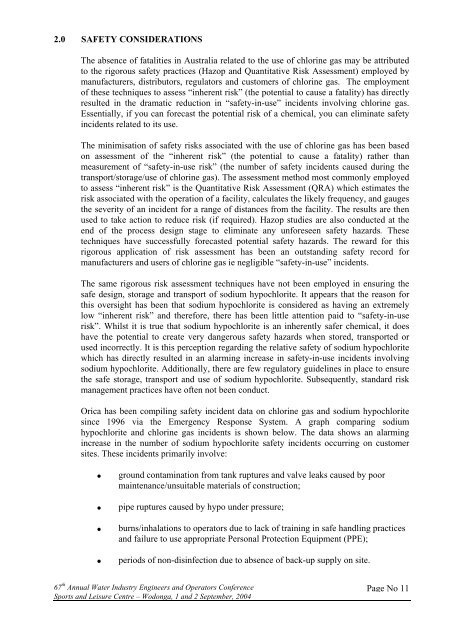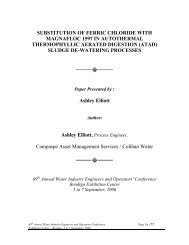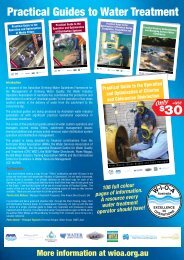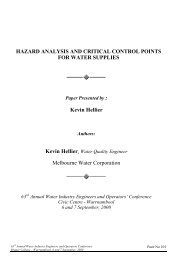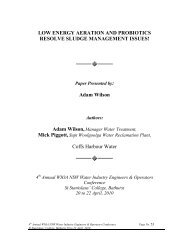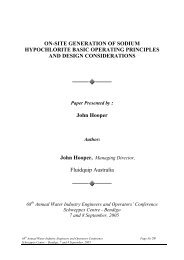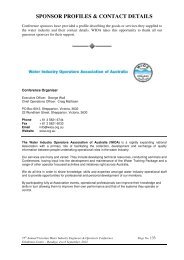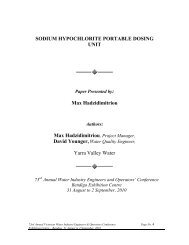CHLORINE GAS V's SODIUM HYPOCHLORITE - WIOA
CHLORINE GAS V's SODIUM HYPOCHLORITE - WIOA
CHLORINE GAS V's SODIUM HYPOCHLORITE - WIOA
Create successful ePaper yourself
Turn your PDF publications into a flip-book with our unique Google optimized e-Paper software.
2.0 SAFETY CONSIDERATIONSThe absence of fatalities in Australia related to the use of chlorine gas may be attributedto the rigorous safety practices (Hazop and Quantitative Risk Assessment) employed bymanufacturers, distributors, regulators and customers of chlorine gas. The employmentof these techniques to assess “inherent risk” (the potential to cause a fatality) has directlyresulted in the dramatic reduction in “safety-in-use” incidents involving chlorine gas.Essentially, if you can forecast the potential risk of a chemical, you can eliminate safetyincidents related to its use.The minimisation of safety risks associated with the use of chlorine gas has been basedon assessment of the “inherent risk” (the potential to cause a fatality) rather thanmeasurement of “safety-in-use risk” (the number of safety incidents caused during thetransport/storage/use of chlorine gas). The assessment method most commonly employedto assess “inherent risk” is the Quantitative Risk Assessment (QRA) which estimates therisk associated with the operation of a facility, calculates the likely frequency, and gaugesthe severity of an incident for a range of distances from the facility. The results are thenused to take action to reduce risk (if required). Hazop studies are also conducted at theend of the process design stage to eliminate any unforeseen safety hazards. Thesetechniques have successfully forecasted potential safety hazards. The reward for thisrigorous application of risk assessment has been an outstanding safety record formanufacturers and users of chlorine gas ie negligible “safety-in-use” incidents.The same rigorous risk assessment techniques have not been employed in ensuring thesafe design, storage and transport of sodium hypochlorite. It appears that the reason forthis oversight has been that sodium hypochlorite is considered as having an extremelylow “inherent risk” and therefore, there has been little attention paid to “safety-in-userisk”. Whilst it is true that sodium hypochlorite is an inherently safer chemical, it doeshave the potential to create very dangerous safety hazards when stored, transported orused incorrectly. It is this perception regarding the relative safety of sodium hypochloritewhich has directly resulted in an alarming increase in safety-in-use incidents involvingsodium hypochlorite. Additionally, there are few regulatory guidelines in place to ensurethe safe storage, transport and use of sodium hypochlorite. Subsequently, standard riskmanagement practices have often not been conduct.Orica has been compiling safety incident data on chlorine gas and sodium hypochloritesince 1996 via the Emergency Response System. A graph comparing sodiumhypochlorite and chlorine gas incidents is shown below. The data shows an alarmingincrease in the number of sodium hypochlorite safety incidents occurring on customersites. These incidents primarily involve:• ground contamination from tank ruptures and valve leaks caused by poormaintenance/unsuitable materials of construction;• pipe ruptures caused by hypo under pressure;• burns/inhalations to operators due to lack of training in safe handling practicesand failure to use appropriate Personal Protection Equipment (PPE);• periods of non-disinfection due to absence of back-up supply on site.67 th Annual Water Industry Engineers and Operators ConferenceSports and Leisure Centre – Wodonga, 1 and 2 September, 2004Page No 11


